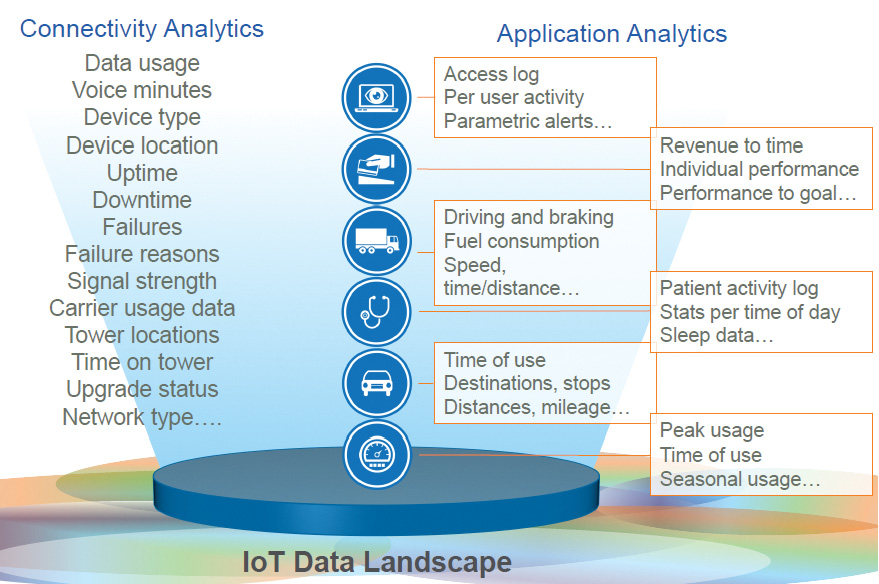To say that application or sensor data analytics is a key focus right now in the M2M/IoT market is a statement of the obvious. Everyone, it seems, is focused on the value that can be created by gathering enormous amounts of application and sensor-related data.
To be sure, making the most of this requires an in-depth understanding of the individual applications that these streams of data relate to. In other words, to make most sense of the data captured from applications – which will increasingly need to be processed in real time – requires specialist knowledge in that vertical application. What is required in one vertical sector is going to increasingly diverge from requirements in any other vertical.
So where does that leave connectivity providers, who support all applications from a horizontal perspective but typically do not have the detailed knowledge of operating in any one vertical?
As a leading connectivity provider in the M2M/IoT market, operating throughout North America and now increasingly in Europe, Aeris has been researching this for some time. They have examined closely the real opportunities for creating new value for their customers from more detailed connectivity – or network – analytics. Their response to this is a new analytics platform called AerVoyance and it offers intriguing new ways of utilising connectivity data.
Connectivity for IoT is not a done deal
Those who focus on application data analytics tend to assume that the connectivity is a done deal, that it all works and is already a 100% reliable, and that the story has moved on to creating value from the applications. Are they building on solid ground though? “Wireless” is not as predictable as “wired” and for the IoT environment that we all envisage, with billions of connections; the vast majority will be wireless connections, not wired. Not all of these will be cellular of course – not by a long way – but wireless nevertheless. The connectivity platform is by no means a done deal for the numbers of connections envisaged and if the connectivity is not stable for millions of devices, then the application data will not be complete and therefore not reliable.
There are many different potential problems that can occur with remote connected devices. If it’s a cellular connection, it might be because the device itself has developed a fault, or maybe its battery is going flat faster than expected. Why would that happen? Maybe the battery needs replacing, or maybe it is getting a weaker signal than it used to get so needs to use more amplification and therefore more power. Alternatively, it might be moving out of range of network coverage completely. If it’s a 2G device, that may be due to the Mobile Operator switching off a particular cell tower that was working fine just yesterday as part of its declared 2G sun-setting. Maybe the data plan being used for the device in its particular location is not appropriate and needs to be revised. Maybe the particular network the device is assigned to, does not have the coverage needed. Maybe roaming is required, maybe a change to another network. It may be a whole host of things. In all, there are very many different reasons why the connectivity for any one particular device might fail.
Then again, when it comes to individual customers managing their population of connected devices in the field, it is no problem at all when you have just 500 such devices. If one of them stops working suddenly, it is not too difficult to find the time to investigate manually what went wrong and correct it. It gets rather more difficult to do that manually when you have 5,000 such devices and virtually impossible for 50,000. Nevertheless, with the way these applications are now developing and the expectations for the M2M/IoT market generally, the prospect of having to manage 500,000 devices or more is fast approaching. How do you manage that many devices, making sure that problem are diagnosed quickly and dealt with rapidly? It is not remotely realistic to do this manually. It has to be automated both for speed and for cost, but how do you automate that sort of process?
Aeris passed the point of five million devices connected to its platform earlier this year. That is already a large operation to keep track of but, with the current growth prospects in the M2M/IoT market, that base is expected to double within the next 18 months or so. The company already collects huge amounts of data on a daily basis on the connectivity events that happen in supporting those connected devices so connectivity analytics – in the shape of the AerVoyance Analytics Suite – is their response to the challenge of providing a rapid and appropriate response when things goes wrong.
What Connectivity Analytics offers
Figure 1: Deeper Analytics Provides Increasing Value
Figure 1 shows typical differences between Connectivity Analytics, on the left, and Application Analytics, on the right. As this shows, the data required on the right is application specific. It is not useful to collect the same data for each application – it needs to be focused on where the value for the customer is and that tends to be very different for each. On the other hand, the data required on the left for connectivity is common for all applications.
To get a sense of the amount of data available in this category, the Aeris connectivity platform currently collects about one billion connectivity-related events per day, covering such details as signal strength at any time for each connected device, which cell tower connected to, network type, device type, device location, time of failure, downtime, and so forth. However, while this data is common to all connections and all applications, some of the detail is more important and relevant for some applications than others. What is needed is an analytics engine able to sift through this huge amount of data to determine where the value lies for any particular user. For Aeris, this is the AerVoyance Analytics Suite.
Where’s the value?
Figure 2: Connectivity versus Application Analytics
Figure 2 shows a schema for increasing value from connectivity analytics. At the basic level, if something goes wrong then straightforward Descriptive Analytics can report this and present it in the most usable form. Getting to why it happened with Diagnostic Analytics is clearly more valuable and if this can be provided straight away then remedial action can reduce any downtime. This highlights the value of Predictive Analytics – aiming to avoid downtime completely by assessing what is likely to happen. However the greatest value comes from Prescriptive Analytics – how to prevent things from potentially going wrong at all? The figure also shows examples of connectivity issues for each of these stages. This is a move away from the traditional break/fix model of M2M towards an optimisation model of improving efficiency and effectiveness of operations – precisely where the IoT aims to go.
There is a clear relationship to value and potential pricing for each of these stages. In the case of Aeris AerVoyance, a freemium model has been adopted where the first stage is free and subsequent stages provide progressively more value at higher prices. The key question is then – what value does reducing the prospect of downtime represent? Ultimately this depends on how critical the application is to the customer.
 In general terms Beecham Research’s own findings in a variety of recent surveys indicate that there is an increasing trend towards M2M/IoT solutions that involve using larger numbers of connected devices and that these are becoming more mission critical. Such solutions are moving away from being the closed domain of just the service department and more towards enterprise-wide usage, typically with the application data captured being used for different purposes. Further than that, though, such solutions are becoming more central to revenue generation, not just cost reduction. For most applications, revenue generation is much closer to being mission critical. Downtime, or indeed inefficient operation, will become increasingly costly.
In general terms Beecham Research’s own findings in a variety of recent surveys indicate that there is an increasing trend towards M2M/IoT solutions that involve using larger numbers of connected devices and that these are becoming more mission critical. Such solutions are moving away from being the closed domain of just the service department and more towards enterprise-wide usage, typically with the application data captured being used for different purposes. Further than that, though, such solutions are becoming more central to revenue generation, not just cost reduction. For most applications, revenue generation is much closer to being mission critical. Downtime, or indeed inefficient operation, will become increasingly costly.
The connectivity of the IoT solution needs to be viewed as part of that, and indeed just as likely to have a problem as any other part, particularly at scale and particularly where higher data speeds are required for real time operations. Aeris Communications is a major connectivity provider in the rapidly-growing M2M/IoT market. The company’s expertise is in connectivity, not in the detail of all the different applications they enable through that connectivity. To deal with that effectively, the company already collects vast amounts of connectivity event data on a daily basis. Using the AerVoyance Analytics Suite then makes sense of that data for its customers, and provides the basis for a whole new revenue stream.
Beecham Research Limited (BRL) is a technology market research, analysis and consulting firm established in 1991, specialising in the development of the rapidly-growing M2M and IoT market worldwide since 2001. BRL clients come from all parts of the value chain including components and hardware, networks and connectivity (cellular, fixed, satellite, short/long range), system integration, application development, distribution and enterprise adoption in both B2B and B2C markets.
Robin Duke-Woolley is CEO of Beecham Research












